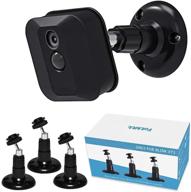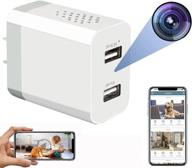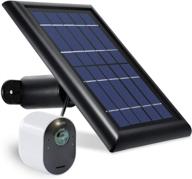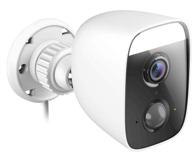
Review on 🔌 Convenient Arlo Accessory: Charging Station for Pro, Pro 2 - VMA4400C Compatible by Jeff Henkhaus

Useful and convenient for Arlo camera system maintenance; You must purchase at least one battery with this product to be useful
I have an Arlo Pro home security/surveillance system. Each of my four Arlo Pro cameras came with a rechargeable Arlo battery (four batteries total), and the 'kit' included a 'Wall Wart' charger. Here's what happened: At one point, one of the four camera batteries died, and the Arlo system sent me a text message and email telling me that the camera battery was low and needed to be charged or replaced. Kudos to Arlo/Netgear for letting me name each camera and the alerts are something like "Basement camera is low" or "Living room camera is low". The problem is that I had four cameras and only four batteries; When that battery died, I had to remove the camera from its location, move it to where the only charger was, open the waterproof charging door on the camera, connect the charger, wait several hours. , then turn off the camera and reinstall it. This camera does not work during charging time. With every other battery-powered device I own, whether it's a hand drill or a digital camera, I usually carry one or more spare batteries with me, and at least one battery is always plugged into an outlet. into the charger and is therefore immediately ready for use to keep the devices running. I asked Arlo/Netgear if they have a similar accessory for the Arlo Pro system and they referred me to this "Arlo Pro charging station". Be the same as the charger that came with the original Arlo camera. The wall charger plugs into the center of the charging station, and the rest of the charging station is really just a couple of outlets that you can plug (or dock) Arlo batteries into. A battery can be docked at each end of the charging station. Sliding the battery into the dock locks it in place and a slight push again releases it and the spring pushes it out of the dock so you can grab it to pull it all the way out. This is roughly how you insert an SD memory card into a digital camera and press again to eject it. There are two LEDs on the top of the charging station that indicate the charging status of the two batteries. If only one battery is connected, it will charge at the same rate as if you simply plugged the camera into Arlo's included charger with the battery dead. If you connect two discharged batteries to the charging station at the same time, they will be charged about twice as fast as individually. You can always leave a battery or two in the charger, fully charged and ready to go (I checked with Arlo/Netgear tech support as the product documentation and specs don't mention it). It's important to note that this product DOES NOT contain batteries, so you will need to purchase an Arlo battery or two with this product if you want to use it as intended. There's not much point in buying one if you don't have at least one spare battery on hand to charge and charge while each of your Arlo Pro cameras uses the main fleet of batteries that came with the Arlo product. First. Therefore, please keep the cost in mind when deciding whether or not you would benefit from purchasing this product. Now, when I get an Arlo warning that my camera's battery is low, I remove one of the two charged batteries from the cradle. , take it to the camera, replace the dead battery and place the dead battery in the charging station so it's ready when the next camera is needed. It only takes a minute or two and is definitely superior to the alternative. But of course you have to pay for this comfort. A few notes. I bought it with two new Arlo batteries of the same model that came with my camera. I bought all of these when I got a low battery warning and thanks to Revain Prime I had it all in a few days and the battery was still low enough to keep the camera running for that period of time. I left both new batteries on the charging station overnight and both turned on the FULL LEDs. But when I replaced one of the two new, fully charged batteries in the camera in question, it worked after the battery swap and the Arlo app indicated that the battery was registered as low. A few experiments followed and in the end I was able to determine that one of the two new batteries was defective, although the charging station indicated that it was charged. I used the charging station to charge an initially dead battery, which then worked fine with my original camera, and made a note of which of the two docks on the charging station I used to charge that battery. I then used the Arlo app to determine which of the other three cameras had the next lowest battery and charged that battery in a different dock on the charging station and then turned it back on. This proved that both charging station docks are actually capable of fully charging their respective batteries. I then took a clearly defective battery and attempted to charge it 'in camera' using the single wall charger that originally came with the camera 'kit' and that battery failed upon putting it back into service . I contacted Arlo Technical Support, who agreed with my troubleshooting methods and analysis, and asked me to specifically label the failed battery and then send it back to Revain for replacement. Presumably the special markings will be used when Revain eventually ships the failed battery back to Arlo. I mention all of this because a) while Arlo batteries (and Arlo products in general) appear high quality, defective batteries are not uncommon and b) even if the battery fails, this charging station can indicate that the battery is fully charged and is not actually fully charged. These batteries, like many (most?) lithium-ion batteries, have multiple pins on their electrical charge connectors, as each individual cell in the battery is being charged and monitored (as opposed to all cells in the battery as a whole). From the looks of it, one or more cells in this faulty battery were either defective or not properly connected internally, so the charger was fine when it wasn't, at least according to the camera. My second comment is that I would rather have Arlo provide some simple means of indicating which of the two battery docks to use preferentially the next time a charged battery is needed, so that the user doesn't always have to use only one side of the docking stations used and maybe ignoring/neglecting the battery in another dock. It's human nature to always use the same dock or forget which one was last used. In the absence of such a feature, I put a small piece of plastic on top of the dock that I plan to use the next time a charged battery is needed, and then move that piece of plastic to a different dock every time I change the battery. My third comment I think it's a good idea to label each battery in your fleet (in my case I numbered the four original batteries 1 through 4 and the two new batteries were labeled 5 and 6; I have for this purpose using a black sharpie pen) . You can record battery usage if you want, but at least if you suspect a problem with the battery or charger, it would help to number the batteries.
- Acceptable
- Minor
New products
Comments (3)

Top products in 👁️🗨️ Video Surveillance

Blink XT/XT2 Camera Wall Mount Bracket - 360° Adjustable for Indoor/Outdoor Use - 3 Pack

11 Review

WiFi Hidden Spy Camera with Live Feed & Video Recording - Remote Access Mini Nanny Cam | Spy Camera Wireless Hidden for Home Surveillance

11 Review

Wasserstein Solar Panel 13 1Ft Compatible Camera & Photo and Video Surveillance

11 Review

📷 D-Link Outdoor Security Spotlight WiFi Camera with Day and Night Vision, Built-In Smart Home Hub, Full HD Surveillance Network System (DCS-8630LH-US) in White

12 Review








